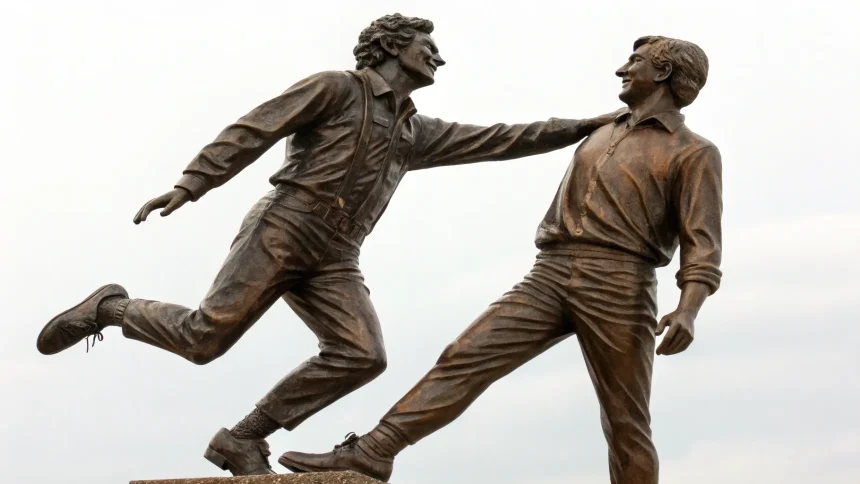A bronze statue created by an unknown artist has captured attention for its portrayal of two male figures in a moment of shared happiness. The artwork depicts the subjects holding hands while frolicking together, with one figure’s foot kicked back in a gesture that conveys joy and playfulness.
The anonymous nature of the creator adds an element of mystery to the piece, which stands as a representation of male intimacy and companionship. Art historians and viewers alike have noted the statue’s expressive quality and the emotional connection it portrays between the two figures.
Artistic Expression and Representation
The bronze medium gives the statue permanence and weight, contrasting with the lightness of the moment it captures. Bronze has historically been used for commemorative and significant works, suggesting the importance of the relationship being depicted.
The positioning of the figures—holding hands with one foot kicked back—creates a dynamic composition that suggests movement and spontaneity. This pose breaks from traditional static representations often seen in classical sculpture.
“The kicked-back foot is particularly significant as it communicates a sense of abandonment to the moment,” notes an art historian familiar with similar works. “This gesture has been used throughout art history to signify joy or celebration.”
Historical Context of Same-Sex Representation
The statue joins a long tradition of artworks depicting same-sex relationships throughout history. From ancient Greek vase paintings to Renaissance drawings, artists have documented intimate relationships between people of the same gender, though these works have often been overlooked or reinterpreted in historical accounts.
Without knowing the date of creation, it’s difficult to place this particular bronze within its specific historical context. However, the anonymous nature of the creator might reflect periods when such expressions were not openly accepted or when artists feared backlash for creating works depicting same-sex intimacy.
The anonymity of certain artworks often speaks volumes about the social climate in which they were created.
Material and Technique
Bronze casting is a complex process that requires significant skill and resources. The choice of this durable material suggests an intention for the work to endure, perhaps as a statement about the lasting nature of the relationship it portrays.
The technical aspects of the statue include:
- Use of bronze, a material associated with permanence and value
- Detailed rendering of two figures in motion
- Capture of a specific emotional moment through posture
- Emphasis on the connected hands as a focal point
The statue stands as a testament to artistic skill in capturing human emotion and connection. Without attribution to a specific artist, the work invites viewers to focus solely on its content and emotional impact rather than on the reputation or intentions of its creator.
As museums and collections increasingly highlight works depicting diverse relationships and experiences, pieces like this bronze statue provide important visual documentation of joy and intimacy between men throughout history. The work continues to speak to audiences today about human connection, regardless of when it was created or by whom.









